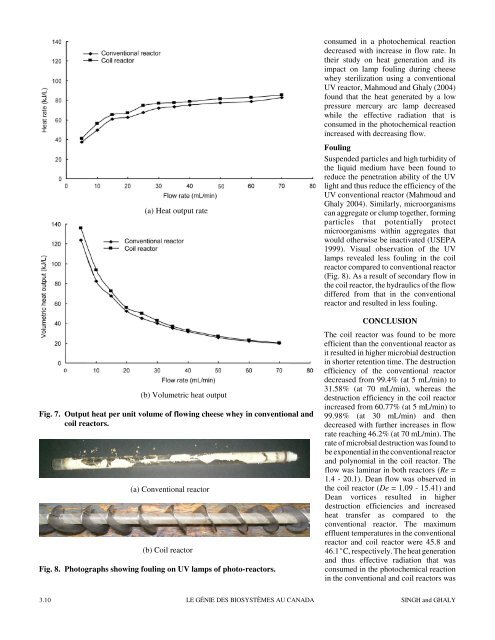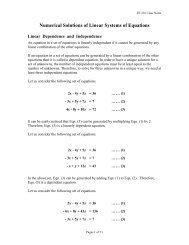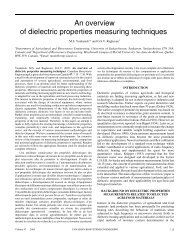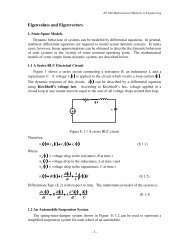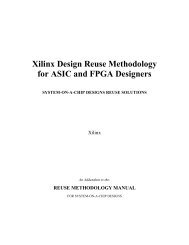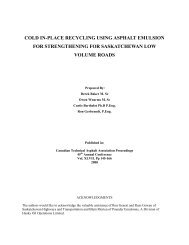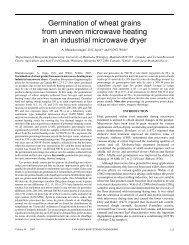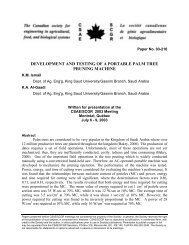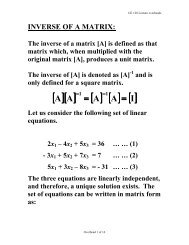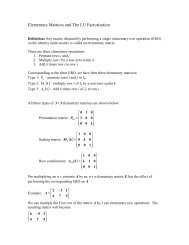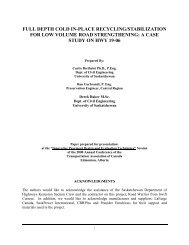(a) Heat output rate(b) Volumetric <strong>heat</strong> outputFig. 7. Output <strong>heat</strong> per unit volume <strong>of</strong> flowing cheese whey in conventional <strong>and</strong>coil reactors.(a) Conventional reactor(b) Coil reactorFig. 8. Photographs showing fouling on UV lamps <strong>of</strong> photo-reactors.consumed in a photochemical reactiondecreased with increase in flow rate. Intheir study on <strong>heat</strong> <strong>generation</strong> <strong>and</strong> itsimpact on lamp fouling <strong>during</strong> cheesewhey <strong>sterilization</strong> using a conventionalUV reactor, Mahmoud <strong>and</strong> Ghaly (2004)found that the <strong>heat</strong> generated by a lowpressure mercury arc lamp decreasedwhile the effective radiation that isconsumed in the photochemical reactionincreased with decreasing flow.FoulingSuspended particles <strong>and</strong> high turbidity <strong>of</strong>the liquid medium have been found toreduce the penetration ability <strong>of</strong> the UVlight <strong>and</strong> thus reduce the efficiency <strong>of</strong> theUV conventional reactor (Mahmoud <strong>and</strong>Ghaly 2004). Similarly, microorganismscan aggregate or clump together, formingparticles that potentially protectmicroorganisms within aggregates thatwould otherwise be inactivated (USEPA1999). Visual observation <strong>of</strong> the UVlamps revealed less fouling in the coilreactor compared to conventional reactor(Fig. 8). As a result <strong>of</strong> secondary flow inthe coil reactor, the hydraulics <strong>of</strong> the flowdiffered from that in the conventionalreactor <strong>and</strong> resulted in less fouling.CONCLUSIONThe coil reactor was found to be moreefficient than the conventional reactor asit resulted in higher microbial destructionin shorter retention time. The destructionefficiency <strong>of</strong> the conventional reactordecreased from 99.4% (at 5 mL/min) to31.58% (at 70 mL/min), whereas thedestruction efficiency in the coil reactorincreased from 60.77% (at 5 mL/min) to99.98% (at 30 mL/min) <strong>and</strong> thendecreased with further increases in flowrate reaching 46.2% (at 70 mL/min). Therate <strong>of</strong> microbial destruction was found tobe exponential in the conventional reactor<strong>and</strong> polynomial in the coil reactor. Theflow was laminar in both reactors (Re =1.4 - 20.1). Dean flow was observed inthe coil reactor (De = 1.09 - 15.41) <strong>and</strong>Dean vortices resulted in higherdestruction efficiencies <strong>and</strong> increased<strong>heat</strong> transfer as compared to theconventional reactor. The maximumeffluent temperatures in the conventionalreactor <strong>and</strong> coil reactor were 45.8 <strong>and</strong>46.1EC, respectively. The <strong>heat</strong> <strong>generation</strong><strong>and</strong> thus effective radiation that wasconsumed in the photochemical reactionin the conventional <strong>and</strong> coil reactors was3.10LE GÉNIE DES BIOSYSTÈMES AU CANADA SINGH <strong>and</strong> GHALY
affected by flow rate. The portion <strong>of</strong> input energy that wasconverted to <strong>heat</strong> increased from 37.18 to 82.67 kJ/h in theconventional reactor <strong>and</strong> from 40.80 to 85.49 kJ/h in the coilreactor when flow rate was increased from 5 to 70 mL/min. The<strong>heat</strong> gain per unit volume <strong>of</strong> the flowing cheese whey decreasedfrom 123.93 to 19.68 kJ/L in the conventional reactor <strong>and</strong> from136.0 to 20.35 kJ/Lin the coil reactor when the flow rate wasincreased from 5 to 70 mL/min. The effective UV radiationdecreased from 52.82 to 7.33 kJ/h in the conventional reactor<strong>and</strong> from 49.20 to 4.51 kJ/h in the coil reactor when the flowrate was increased from 5 to 70 mL/min. Fouling in the coilreactor was less compared to the conventional reactor.ACKNOWLEDGEMENTThis research was funded by the Natural Sciences <strong>and</strong>Engineering Research Council <strong>of</strong> Canada (NSERC).REFERENCESAbu-Ghararah, Z.H. 1994. Effect <strong>of</strong> temperature on the kinetics<strong>of</strong> wastewater disinfection using ultraviolet radiation.Journal <strong>of</strong> Environmental Science <strong>and</strong> Health A29 (3): 585-603.APHA. 1967. St<strong>and</strong>ard Methods for the Examination <strong>of</strong> DairyProducts. Washington, DC: American Public HealthAssociation.Ben-Hassan, R.M., A.E. Ghaly <strong>and</strong> N. Ben-Abdallah. 1993.Heat <strong>generation</strong> <strong>during</strong> batch <strong>and</strong> continuous production <strong>of</strong>single cell protein from cheese whey. Biomass <strong>and</strong>Bioenergy 4(3): 213-225.Blatchley, E.R.K. 1997. Numerical modeling <strong>of</strong> UV intensity:Application to collimated-beam reactors <strong>and</strong> continuousflowsystems. Water Research 31(9): 2205-2218.Blatchley, E.R. <strong>and</strong> M.M. Peel. 2001. Disinfection byultraviolet irradiation. In Disinfection, Sterilization <strong>and</strong>Preservation, 5 th edition, ed. S.S. Block, 823 - 852.Philadelphia, PA: Lippincott Williams & Wilkins.Brewster, M.E., K.Y. Chung <strong>and</strong> G. Belfort. 1993. Deanvortices with wall flux in a curved channel membranesystem: A new approach to membrane module design.Journal <strong>of</strong> Membrane Science 81:127–137.Cengel, Y.A. 2003. Heat Transfer: A Practical Approach, 2 ndedition. Boston, MA: McGraw-Hill.Ghaly, A.E. <strong>and</strong> A.A. El-Taweel. 1995. Effect <strong>of</strong> lactoseconcentration on batch production <strong>of</strong> ethanol from cheesewhey using C<strong>and</strong>ida Pseudotropicalis. Transactions <strong>of</strong> theASAE 38(4): 1113-1120.Ghogomu, J.N., C. Guigui, J.C. Rouch, M.J. Clifton <strong>and</strong> P.Aptel. 2001. Hollow-fibre membrane module design:Comparison <strong>of</strong> different curved geometries with Deanvortices. Journal <strong>of</strong> Membrane Science 181 (1): 71-80.Holman, J.P. 2002. Heat Transfer, 9 th edition. New York, NY:McGraw-Hill.Khomich, V.A., I.A. Soloshenko, V.V. Tsiolko <strong>and</strong> I.L Mikhno.1998. Investigation <strong>of</strong> principle factors <strong>of</strong> the <strong>sterilization</strong> byplasma DC glow discharge. In Proceedings <strong>of</strong> ICPP & 25 thEPS Conference on Controlled Fusion <strong>and</strong> Plasma Physics,ed. P. Pavlo, Vol. 22C: 2745-2748. European PhysicalSociety.Koch, A.L. 1995. Bacterial Growth <strong>and</strong> Form. New York, NY:Chapman & Hall.Koutchma, T., S.K. Stuart, C. Stuary <strong>and</strong> B. Parisi. 2004.Ultraviolet disinfection <strong>of</strong> juice products in laminar <strong>and</strong>turbulent flow reactors. Innovative Food Science <strong>and</strong>Emerging Technologies 5: 179-189.Mahmoud, N.S. <strong>and</strong> A.E. Ghaly. 2004. On-line <strong>sterilization</strong> <strong>of</strong>cheese whey using ultraviolet radiations. BiotechnologyProgress 20: 550-560.Mallubhotla, H. <strong>and</strong> G. Belfort. 1997. Flux enhancement <strong>during</strong>Dean vortex micr<strong>of</strong>iltration: 8. Further diagnostics. Journal<strong>of</strong> Membrane Science 125: 75-91.Marshall, K.R. <strong>and</strong> W.J. Harper. 1984. Treatment <strong>of</strong> wastesfrom the dairy industry. In Surveys in Industrial WastewaterTreatment, eds. D. Barnes, C.F. Forster <strong>and</strong> S.E. Hrudey,Vol. 1: 296-376. Boston, MA: Pitman Advanced PublishingProgram.McC<strong>and</strong>less, L. 1998. Cider pasteurization via ultraviolet light(UV). http://www.nysaes.cornell.edu/pubs/press/1998/cider_uv_past.html. (2004/07/08)Miller, R.V., W. Jeffrey, D. Mitchell <strong>and</strong> M. Elasri. 1999.Bacterial responses to ultraviolet light. ASM News 65(8):535-541.Mitscherlich, E. <strong>and</strong> E.H. Marth. 1984. <strong>Microbial</strong> Survival inthe Environment. Berlin, Germany: Springer Verlag.Nemeth, J. <strong>and</strong> G. Bucsky. 1997. Secondary flow generated incurved flow. Hungarian Journal <strong>of</strong> Industrial Chemistry 25:91.Qualls, R.G., M.P. Flynn <strong>and</strong> J.D. Johnson. 1983. The role <strong>of</strong>suspended particles in ultraviolet disinfection. Journal <strong>of</strong> theWater Pollution Control Federation 55(10): 1280-1285.Rane, M.V. <strong>and</strong> M.S. T<strong>and</strong>ale. 2005. Water-to-water <strong>heat</strong>transfer in tube-tube <strong>heat</strong> exchanger: Experimental <strong>and</strong>analytical study. Applied Thermal Engineering 25 (17-18):2715-2729.Singh, R.K. <strong>and</strong> A.E. Ghaly. 1988. Cheese whey processingalternatives. ASAE Paper No. 88-6540. St. Joseph, MI:ASABE.Singh, J.P. <strong>and</strong> A.E. Ghaly. 2006. Reduced fouling <strong>and</strong>enhanced microbial inactivation <strong>during</strong> <strong>online</strong> <strong>sterilization</strong><strong>of</strong> cheese whey using UV coil reactors. Bioprocess <strong>and</strong>Biosystems Engineering 29(2): 269-281.Tran, M.T.T. <strong>and</strong> M. Farid. 2004. Ultraviolet treatment <strong>of</strong>orange juice. Innovative Food Science <strong>and</strong> EmergingTechnologies 5(4): 495-502.USEPA. 1999. Wastewater technology fact sheet. Ultravioletdisinfection. EPA 832-F-99-064. Office <strong>of</strong> Water.Environmental Protection Agency, Washington, DC.http://www.epa.gov/owm/mtb/uv.pdf. (2004/06/04)USEPA. 2002. The environmental technology verificationprogram. Inactivation <strong>of</strong> MS2 virus in drinking water.NSF02/03/EPADWCTR. National Science Foundation,Washington, DC. http://www.epa.gov/etv/pdfs/vrvs/02_vr_trojan.pdf. (2005/11/10)Volume 49 2007 CANADIAN BIOSYSTEMS ENGINEERING 3.11


